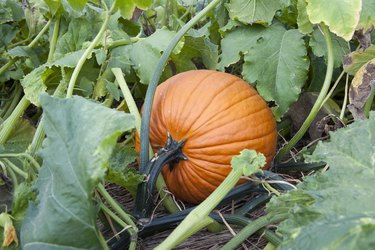
While all zucchinis (Cucurbita pepo, USDA growing zones 3-9) are squash, not every squash (Cucurbita spp., USDA growing zones 3-10) is a zucchini. So are zucchini and pumpkin related? Yes, they are: along with cucumbers, chayote and several gourds, they both belong to the Cucurbitaceae squash or gourd family. The plants can look similar, but there are clear differences.
Pumpkins and Zucchinis
Video of the Day
It's common for people to mistake these plants for one another before their fruits begin to ripen. Zucchini is usually bushy, and most varieties are non-vining. There are a few kinds that creep, but most do not. Zucchini plant leaves are dark green, large and have five to seven lobes that radiate from one point. The leaves and stems have tiny, prickly plant hairs. When the flowers appear, they have five yellowish/orange petals.
Video of the Day
Pumpkins grow on very long vines, and the leaves can be as large as a soccer ball. These leaves are rounder in shape and generally have serrated edges with three or more veins; the pretty flowers are a vibrant orange or yellow. The leaves are usually dark green but can also be light or grayish-green.
Pumpkin Fruit vs. Zucchini Fruit
Once these plants start producing fruit, you can really tell the difference. Zucchini usually has rich green skin, but they can also be medium to bright yellow. Besides that, the general shape is usually straight, but the yellow varieties can have bulbous bottoms and be more tapered towards the tops. Green and yellow squash both have off-white, somewhat spongy interiors, but they will be too soft inside if you harvest them too late into the season. Zucchini is most commonly harvested in summer.
You should harvest most pumpkins in the fall, and while there are more varieties, they are not as versatile for cooking. They can be round, oblong or roundish/flat and vary in color from white to yellow to orange. Their rinds are much thicker and more rigid than zucchini, and they mature in the early autumn, making them perfect for the Halloween season.
Cooking With Zucchini and Squash
Zucchini is among the most popular vegetables among chefs of all skill levels. It can be sliced and eaten raw in salads or served alongside other fresh veggies with dips. Cooks also use spiralizers to make zucchini noodles, sauté them for pasta primavera and grill them with a little bit of sea salt. Other ways to use this vegetable include making it into zucchini bread, fried zucchini, zucchini gratin and zucchini "hash browns."
And on pumpkins, nothing beats the taste of old-fashioned pumpkin pie, which most people traditionally make with canned pumpkin. You can also use pumpkin to make tasty pumpkin bread, cheesecake, pancakes and even pumpkin lasagna. The seeds are also a delicious snack and can be roasted, spiced and added to recipes. Some types of pumpkins are great just baked whole. While cooking fresh pumpkins might entail more work in some cases, it's worth it for flavor.